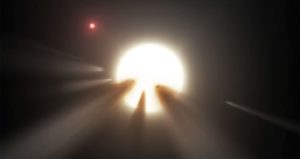That peculiar light in the night sky known as Tabby’s Star is at it again. After causing an uproar in the science community on several occasions as space geeks tried to figure out why it regularly grew brighter and dimmer (by as much as 20%) it mostly stabilized out for the last couple of years. But now, as Science Magazine reports, it’s gone into another dip in brightness and telescopes around the world are turning to give it a fresh look and see if they can solve the mystery.
Astronomers and alien life enthusiasts alike are buzzing over the sudden dimming of an otherwise unremarkable star 1300 light-years away in the constellation Cygnus. KIC 8462852 or “Tabby’s star” has dimmed like this several times before, prompting some researchers to suggest that the megastructures of an advanced alien civilization might be blocking its light. And now—based on new data from numerous telescopes—it’s doing it again.
“This is the first clear dip we have seen since [2013], and the first we have ever caught in real time,” says Jason Wright, an astronomer at Pennsylvania State University in State College. If they can rope in more telescopes, astronomers hope to gather enough data to finally figure out what’s going on. “This could be the first of several dips about to come,” says astronomer David Kipping of Columbia University. “Many observers will be closely watching.”
They’re hoping that everyone possible, even the amateurs with pretty good gear, will keep watch on Tabby’s Star and gather all the data they can. Why? Because they’re desperately trying to come up with a viable explanation as to what’s causing this and the “establishment science media” does not want to admit that it might be aliens. Paul Seaburn at Mysterious Universe goes over a few of the possibilities which have been considered.
Penn State astronomer Jason Wright issued this alert from UC Berkeley SETI’s Breakthrough Listen Lab. You may remember that Wright proposed that the fluctuations in Tabby’ Star may be caused by an artificial alien megastructure known as a Dyson swarm, which is a Dyson sphere made of Dyson rings. Wright is hoping to get as-it’s-happening data from telescopes at Berkeley and the National Radio Astronomy Observatory radio telescope in Green Bank, West Virginia, in addition to what any other astronomers might see…
While the Dyson sphere or swarm idea has been eliminated, others are still under consideration. There’s the ‘swarm of asteroids blocking its light’ theory. Then there’s the ‘Tabby (the star) ate a big planet and it’s digesting it’ theory. Or it could be something else.
If the star “ate a big planet” it must have been an awesomely large one. I was watching a special about this on the Science Channel and one of their resident astrophysicists was of the opinion that our own star could swallow Jupiter and it wouldn’t produce anywhere near that much of a fluctuation. And I don’t want to let the air out of the tires of any alien enthusiasts, but an artificial structure like a Dyson sphere that was big enough to do this would apparently require the ability to build something many times the size of a planet.
Here’s another thought which I always like to toss out when the TV geeks start lecturing us about dark matter and every other theory of the day. Maybe we’re not quite as smart as we think we are yet and don’t know how everything works. Heck.. we still don’t really know how gravity works if you’re being honest about it. Perhaps some really rare stars just do this on their own at some stage in their lives and we’re about to learn something new and really cool. Would that work for you?
The post By the way, that weird alien star is dimming again appeared first on Hot Air.


